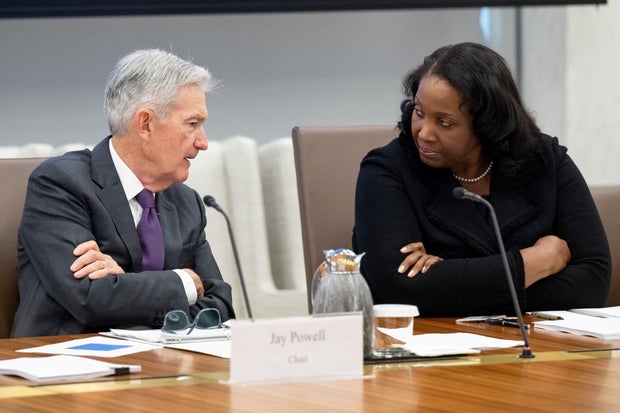Washington — The Trump administration asked the Supreme Court on Thursday to allow President Trump to remove Lisa Cook from her position on the Federal Reserve Board of Governors while a legal challenge to her firing moves forward.
In its request for emergency relief from the high court, the Justice Department said that the justices should freeze a lower court decision that ordered Cook to be reinstated to her post on the Fed Board.
The U.S. Court of Appeals for the District of Columbia Circuit ruled earlier this week that Cook could remain in her role while a legal challenge to her firing moves forward.
Mr. Trump’s emergency appeal to the high court comes after Cook participated in a two-day meeting of the Fed’s committee that sets interest rates this week. The central bank on Wednesday lowered its benchmark interest rate by 0.25 percentage points, its first cut since December. The president has repeatedly criticized the Fed for moving too slowly to lower interest rates.
“That the Federal Reserve Board plays a uniquely important role in the American economy only heightens the government’s and the public’s interest in ensuring that an ethically compromised member does not continue wielding its vast powers,” Solicitor General D. John Sauer wrote in the request to the Supreme Court. “Put simply, the President may reasonably determine that interest rates paid by the American people should not be set by a Governor who appears to have lied about facts material to the interest rates she secured for herself — and refuses to explain the apparent misrepresentations.”
Lisa Cook’s firing
Mr. Trump moved to fire Cook last month over allegations she made misrepresentations on mortgage filings. She has not been charged with any crime and denies wrongdoing. Cook’s removal by Mr. Trump was unprecedented — no president has attempted to remove a Fed governor in the central bank’s 112-year-history. Critics warned that it threatened the independence of the Fed.
Cook swiftly filed a lawsuit against the administration, arguing her removal violated the Federal Reserve Act. The law specifies that a president can only remove a governor “for cause.” Cook also argued her due process rights were violated because she was not provided notice of the allegations against her and a meaningful opportunity to respond.
U.S. District Judge Jia Cobb sided with Cook earlier this month, finding that her firing likely violated the Federal Reserve Act and her right to due process under the Fifth Amendment. She ordered Cook to be reinstated to her post on the Fed Board.
The Trump administration sought emergency relief from the D.C. Circuit Court of Appeals, which left Cobb’s order intact. Judge Bradley Garcia wrote in a concurring opinion that Cook is likely to succeed in her claim that Mr. Trump’s attempt to terminate her violated her due process rights. But he wrote that the court did not need to address the meaning of “for cause” at this stage in the case.
The White House had said the administration would seek the Supreme Court’s intervention, as it has done in several other legal challenges to Mr. Trump’s efforts to remove Democratic-appointed officials at independent agencies. The high court has so far allowed the president to fire members of the National Labor Relations Board, Merit Systems Protection Board and Consumer Product Safety Commission, but it acknowledged in May that the Fed is a “uniquely structured, quasi-private entity that follows in the distinct historical tradition of the First and Second Banks of the United States.”
In his filing, Sauer argued that Cook received adequate notice and opportunity to contest her removal.
“The President notified Cook of the charges against her and waited five days for her to respond before removing her,” he wrote. “Having declined to bring any defense to the President’s attention or to dispute any material facts, Cook cannot complain about insufficient process.”
The solicitor general noted that the administration is not contesting the constitutionality of the for-cause removal protection for members of the Fed Board, but instead believes the president’s firing of Cook complies with it. Still, Sauer said the district court’s finding that conduct that occurred before Cook was appointed to the Fed does not constitute “cause” under the Federal Reserve Act was “flawed.”
“The President’s strong concerns about the appearance of mortgage fraud, based on facially contradictory representations made to obtain mortgages by someone whose job is to set interest rates that affect Americans’ mortgages, satisfies any conception of cause,” he wrote. “That is especially true here, where Cook has not disputed any material fact or offered any plausible justification for her conduct.”
Mr. Trump announced last month that he was firing Cook, who was appointed by President Joe Biden, from the Fed Board of Governors and had “sufficient cause” to oust her. Cook’s 14-year-term on the Fed is set to end in January 2038.
The president cited as grounds for her removal claims made by Bill Pulte, director of the Federal Housing Finance Agency, that Cook made false statements on mortgage documents.
Pulte alleged in a letter to Attorney General Pam Bondi last month that Cook claimed two different properties in Ann Arbor, Michigan, and Atlanta as her principal residence on mortgage documents from 2021 in order to gain more favorable lending terms. Pulte, who was appointed to lead the FHFA by Mr. Trump, has continued to make accusations against Cook related to mortgage documents.
Cook’s lawyers have said she “did not ever commit mortgage fraud.” Documents obtained by The Associated Press this week showed that Cook referred to the property as a “vacation home” in a loan estimate, potentially undercutting the Trump administration’s claims of fraud.

